Pearson BTEC Hospitality Management: Crisis Management Report
VerifiedAdded on 2022/02/10
|24
|7411
|30
Report
AI Summary
This report examines the transformation of leadership and management in the service sector, particularly within the hospitality industry, during the global pandemic. It addresses the critical need for crisis management skills, emphasizing decisive action, proactive strategies, open communication, and ethical considerations as key components of effective leadership. The report delves into classical management theories, including scientific and bureaucratic management, and illustrates their application in service industry contexts, using examples from Crown Resort and Casino of Melbourne to demonstrate how these theories can enhance productivity and organizational structure. The analysis highlights the importance of adapting to changing circumstances and the need for leaders to navigate challenges with flexibility, empathy, and a focus on long-term goals, including how the government can use these theories. This document is a student contribution to Desklib, a platform offering AI-based study tools.
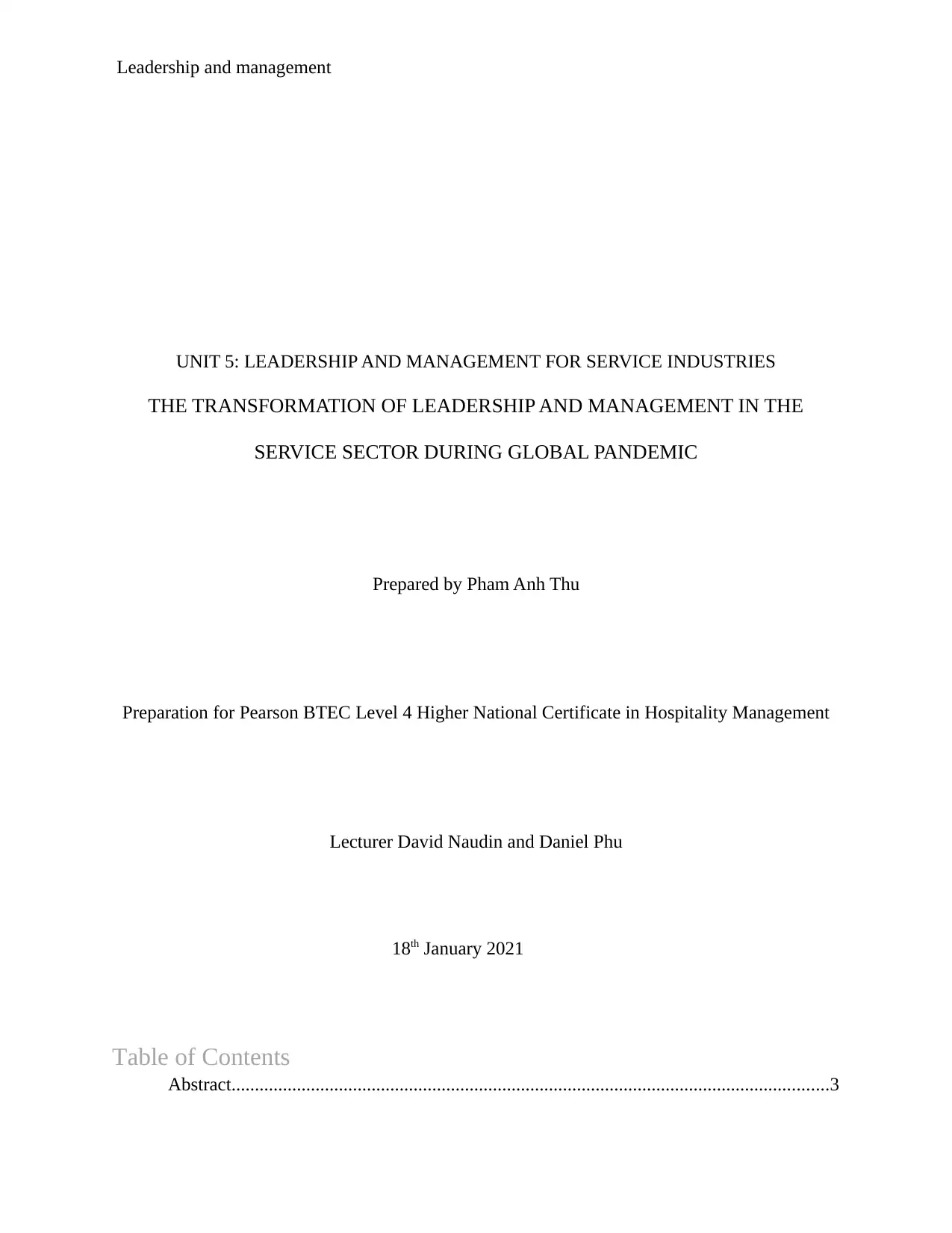
Leadership and management
UNIT 5: LEADERSHIP AND MANAGEMENT FOR SERVICE INDUSTRIES
THE TRANSFORMATION OF LEADERSHIP AND MANAGEMENT IN THE
SERVICE SECTOR DURING GLOBAL PANDEMIC
Prepared by Pham Anh Thu
Preparation for Pearson BTEC Level 4 Higher National Certificate in Hospitality Management
Lecturer David Naudin and Daniel Phu
18th January 2021
Table of Contents
Abstract................................................................................................................................3
UNIT 5: LEADERSHIP AND MANAGEMENT FOR SERVICE INDUSTRIES
THE TRANSFORMATION OF LEADERSHIP AND MANAGEMENT IN THE
SERVICE SECTOR DURING GLOBAL PANDEMIC
Prepared by Pham Anh Thu
Preparation for Pearson BTEC Level 4 Higher National Certificate in Hospitality Management
Lecturer David Naudin and Daniel Phu
18th January 2021
Table of Contents
Abstract................................................................................................................................3
Paraphrase This Document
Need a fresh take? Get an instant paraphrase of this document with our AI Paraphraser
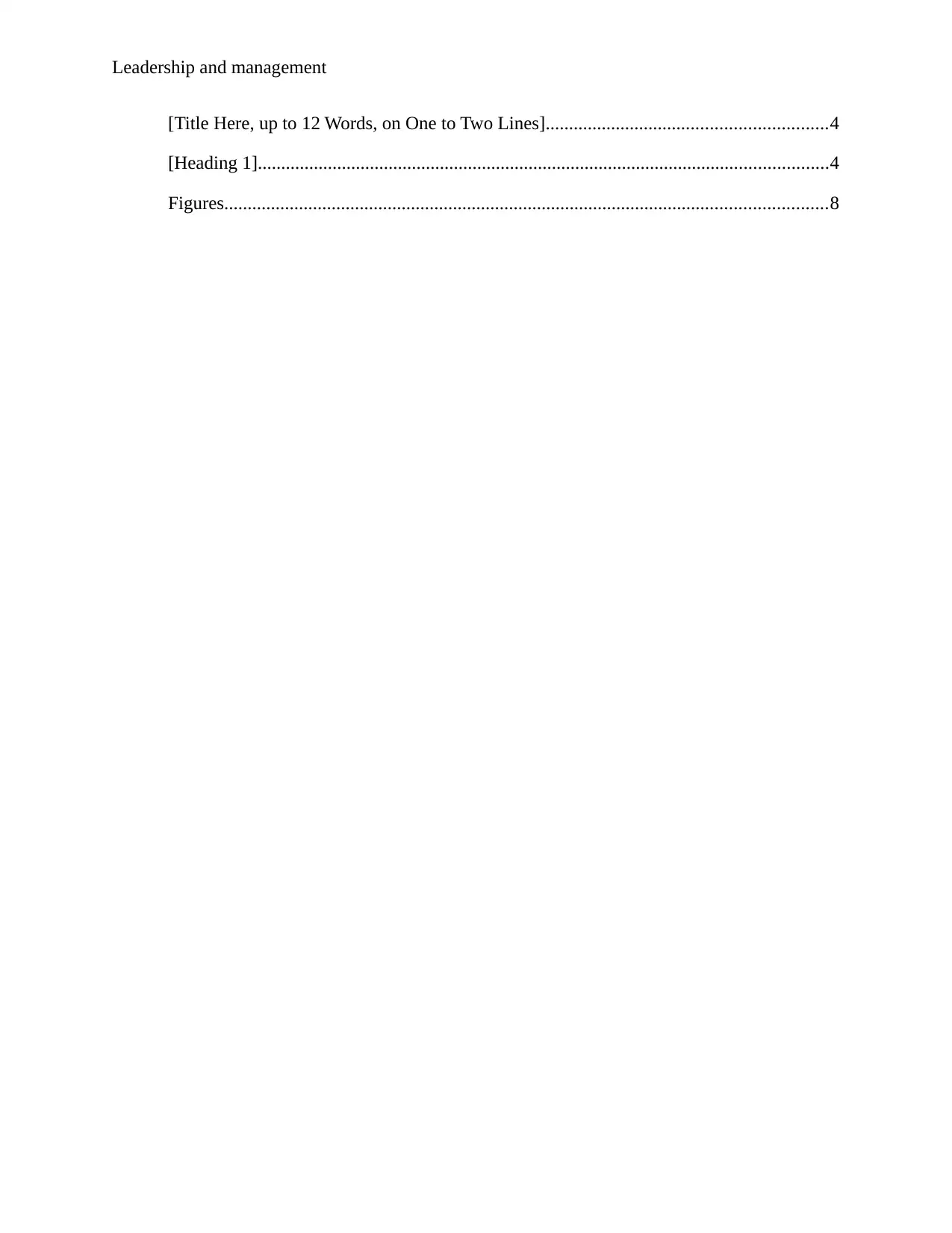
Leadership and management
[Title Here, up to 12 Words, on One to Two Lines]............................................................4
[Heading 1]..........................................................................................................................4
Figures.................................................................................................................................8
[Title Here, up to 12 Words, on One to Two Lines]............................................................4
[Heading 1]..........................................................................................................................4
Figures.................................................................................................................................8
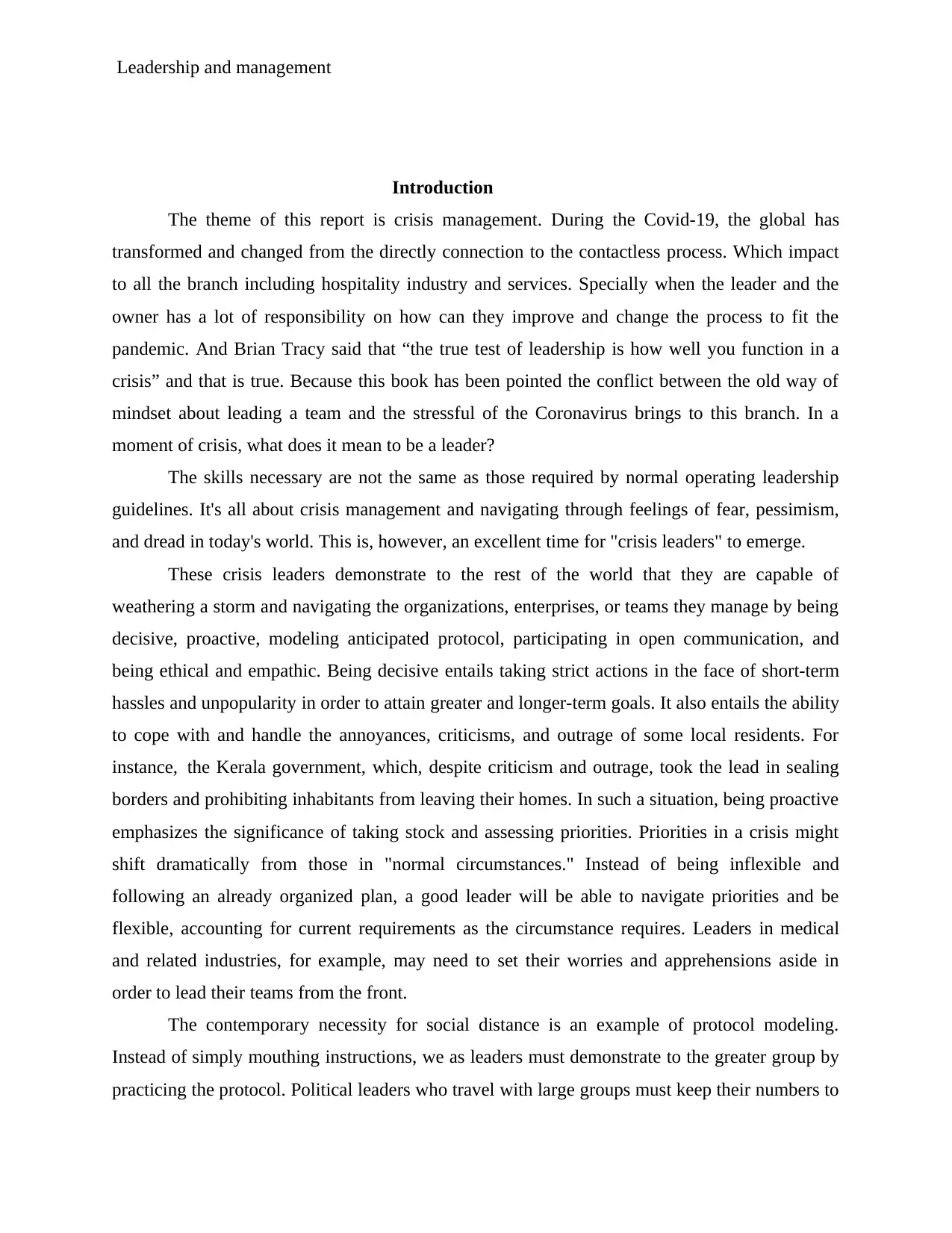
Leadership and management
Introduction
The theme of this report is crisis management. During the Covid-19, the global has
transformed and changed from the directly connection to the contactless process. Which impact
to all the branch including hospitality industry and services. Specially when the leader and the
owner has a lot of responsibility on how can they improve and change the process to fit the
pandemic. And Brian Tracy said that “the true test of leadership is how well you function in a
crisis” and that is true. Because this book has been pointed the conflict between the old way of
mindset about leading a team and the stressful of the Coronavirus brings to this branch. In a
moment of crisis, what does it mean to be a leader?
The skills necessary are not the same as those required by normal operating leadership
guidelines. It's all about crisis management and navigating through feelings of fear, pessimism,
and dread in today's world. This is, however, an excellent time for "crisis leaders" to emerge.
These crisis leaders demonstrate to the rest of the world that they are capable of
weathering a storm and navigating the organizations, enterprises, or teams they manage by being
decisive, proactive, modeling anticipated protocol, participating in open communication, and
being ethical and empathic. Being decisive entails taking strict actions in the face of short-term
hassles and unpopularity in order to attain greater and longer-term goals. It also entails the ability
to cope with and handle the annoyances, criticisms, and outrage of some local residents. For
instance, the Kerala government, which, despite criticism and outrage, took the lead in sealing
borders and prohibiting inhabitants from leaving their homes. In such a situation, being proactive
emphasizes the significance of taking stock and assessing priorities. Priorities in a crisis might
shift dramatically from those in "normal circumstances." Instead of being inflexible and
following an already organized plan, a good leader will be able to navigate priorities and be
flexible, accounting for current requirements as the circumstance requires. Leaders in medical
and related industries, for example, may need to set their worries and apprehensions aside in
order to lead their teams from the front.
The contemporary necessity for social distance is an example of protocol modeling.
Instead of simply mouthing instructions, we as leaders must demonstrate to the greater group by
practicing the protocol. Political leaders who travel with large groups must keep their numbers to
Introduction
The theme of this report is crisis management. During the Covid-19, the global has
transformed and changed from the directly connection to the contactless process. Which impact
to all the branch including hospitality industry and services. Specially when the leader and the
owner has a lot of responsibility on how can they improve and change the process to fit the
pandemic. And Brian Tracy said that “the true test of leadership is how well you function in a
crisis” and that is true. Because this book has been pointed the conflict between the old way of
mindset about leading a team and the stressful of the Coronavirus brings to this branch. In a
moment of crisis, what does it mean to be a leader?
The skills necessary are not the same as those required by normal operating leadership
guidelines. It's all about crisis management and navigating through feelings of fear, pessimism,
and dread in today's world. This is, however, an excellent time for "crisis leaders" to emerge.
These crisis leaders demonstrate to the rest of the world that they are capable of
weathering a storm and navigating the organizations, enterprises, or teams they manage by being
decisive, proactive, modeling anticipated protocol, participating in open communication, and
being ethical and empathic. Being decisive entails taking strict actions in the face of short-term
hassles and unpopularity in order to attain greater and longer-term goals. It also entails the ability
to cope with and handle the annoyances, criticisms, and outrage of some local residents. For
instance, the Kerala government, which, despite criticism and outrage, took the lead in sealing
borders and prohibiting inhabitants from leaving their homes. In such a situation, being proactive
emphasizes the significance of taking stock and assessing priorities. Priorities in a crisis might
shift dramatically from those in "normal circumstances." Instead of being inflexible and
following an already organized plan, a good leader will be able to navigate priorities and be
flexible, accounting for current requirements as the circumstance requires. Leaders in medical
and related industries, for example, may need to set their worries and apprehensions aside in
order to lead their teams from the front.
The contemporary necessity for social distance is an example of protocol modeling.
Instead of simply mouthing instructions, we as leaders must demonstrate to the greater group by
practicing the protocol. Political leaders who travel with large groups must keep their numbers to
⊘ This is a preview!⊘
Do you want full access?
Subscribe today to unlock all pages.

Trusted by 1+ million students worldwide
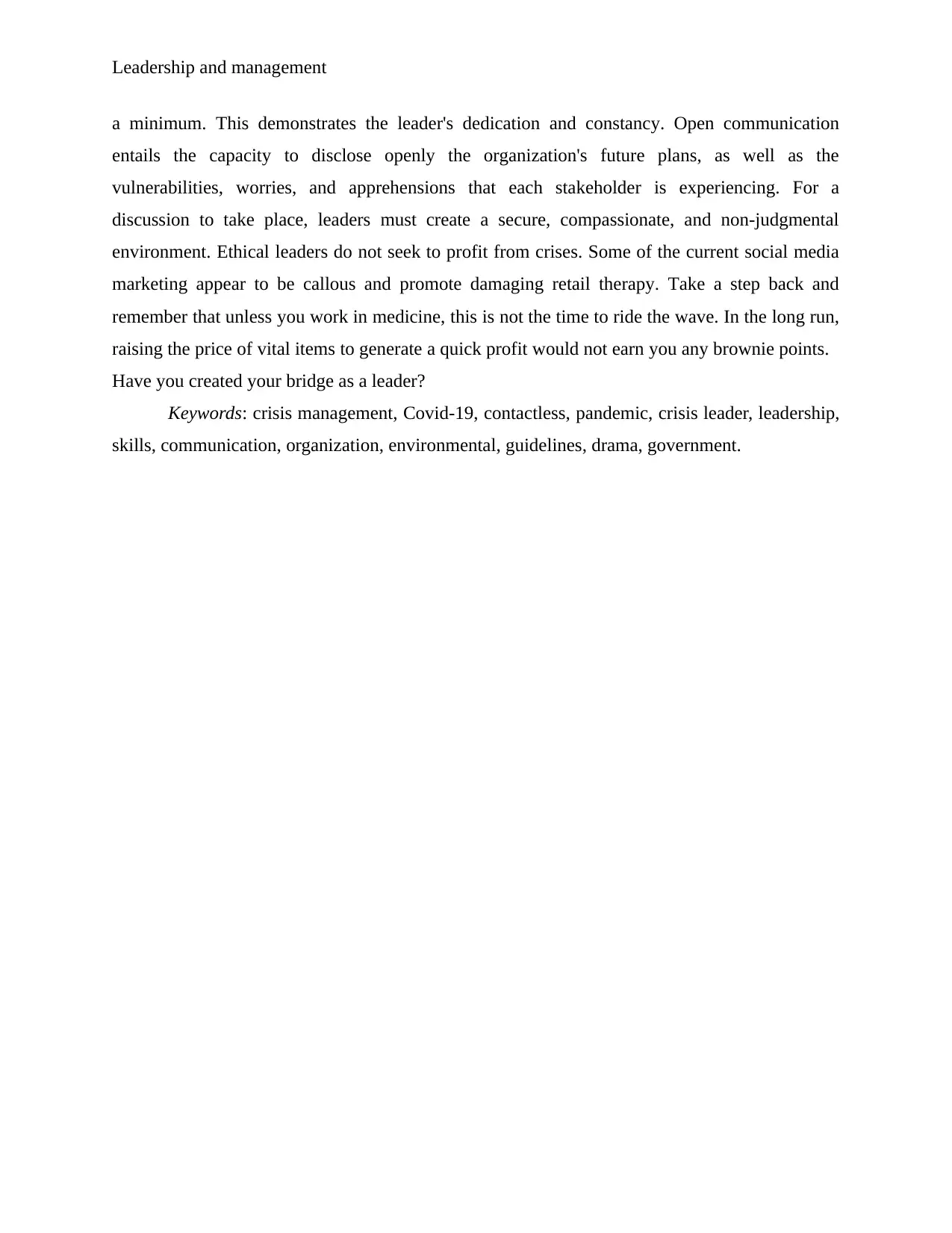
Leadership and management
a minimum. This demonstrates the leader's dedication and constancy. Open communication
entails the capacity to disclose openly the organization's future plans, as well as the
vulnerabilities, worries, and apprehensions that each stakeholder is experiencing. For a
discussion to take place, leaders must create a secure, compassionate, and non-judgmental
environment. Ethical leaders do not seek to profit from crises. Some of the current social media
marketing appear to be callous and promote damaging retail therapy. Take a step back and
remember that unless you work in medicine, this is not the time to ride the wave. In the long run,
raising the price of vital items to generate a quick profit would not earn you any brownie points.
Have you created your bridge as a leader?
Keywords: crisis management, Covid-19, contactless, pandemic, crisis leader, leadership,
skills, communication, organization, environmental, guidelines, drama, government.
a minimum. This demonstrates the leader's dedication and constancy. Open communication
entails the capacity to disclose openly the organization's future plans, as well as the
vulnerabilities, worries, and apprehensions that each stakeholder is experiencing. For a
discussion to take place, leaders must create a secure, compassionate, and non-judgmental
environment. Ethical leaders do not seek to profit from crises. Some of the current social media
marketing appear to be callous and promote damaging retail therapy. Take a step back and
remember that unless you work in medicine, this is not the time to ride the wave. In the long run,
raising the price of vital items to generate a quick profit would not earn you any brownie points.
Have you created your bridge as a leader?
Keywords: crisis management, Covid-19, contactless, pandemic, crisis leader, leadership,
skills, communication, organization, environmental, guidelines, drama, government.
Paraphrase This Document
Need a fresh take? Get an instant paraphrase of this document with our AI Paraphraser
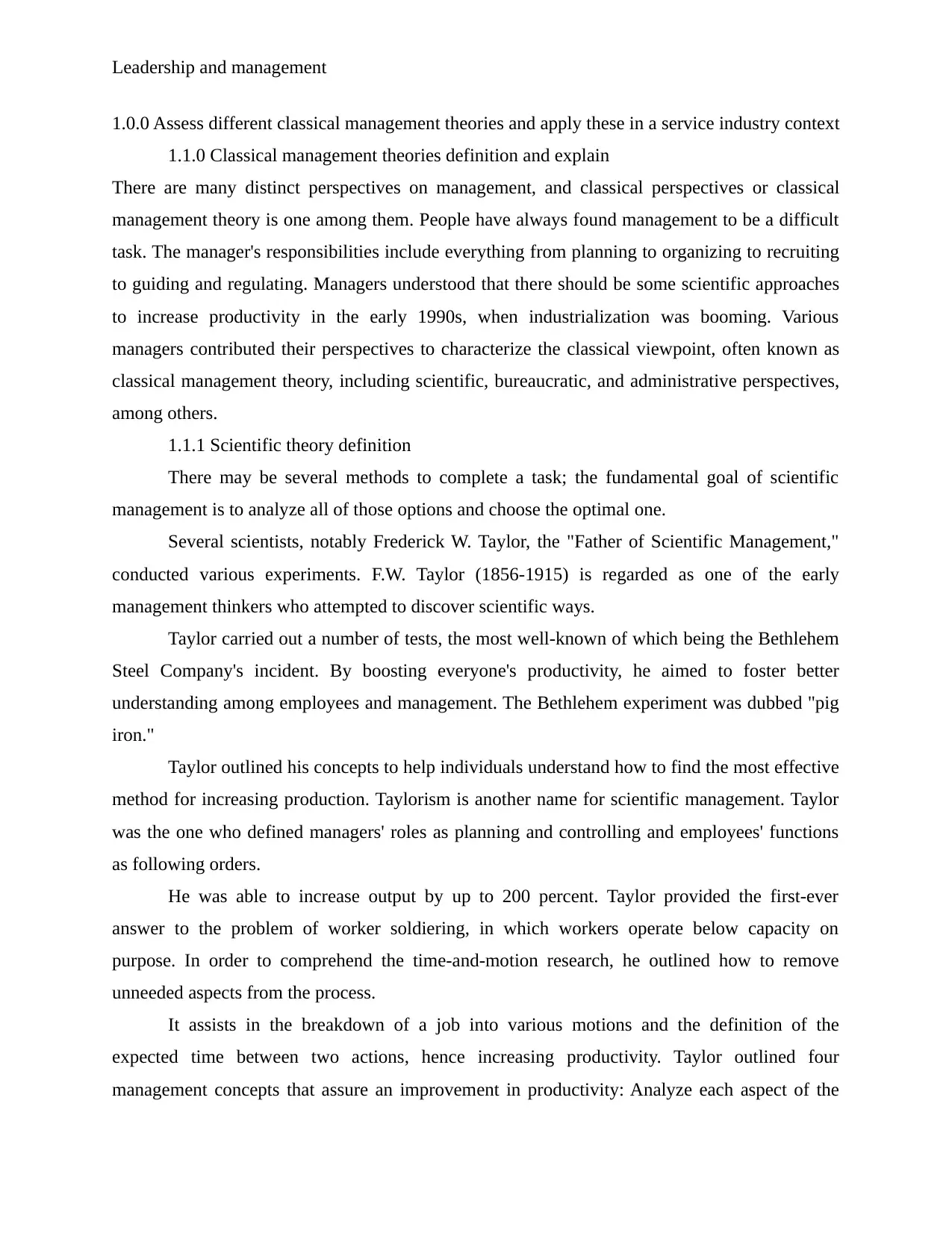
Leadership and management
1.0.0 Assess different classical management theories and apply these in a service industry context
1.1.0 Classical management theories definition and explain
There are many distinct perspectives on management, and classical perspectives or classical
management theory is one among them. People have always found management to be a difficult
task. The manager's responsibilities include everything from planning to organizing to recruiting
to guiding and regulating. Managers understood that there should be some scientific approaches
to increase productivity in the early 1990s, when industrialization was booming. Various
managers contributed their perspectives to characterize the classical viewpoint, often known as
classical management theory, including scientific, bureaucratic, and administrative perspectives,
among others.
1.1.1 Scientific theory definition
There may be several methods to complete a task; the fundamental goal of scientific
management is to analyze all of those options and choose the optimal one.
Several scientists, notably Frederick W. Taylor, the "Father of Scientific Management,"
conducted various experiments. F.W. Taylor (1856-1915) is regarded as one of the early
management thinkers who attempted to discover scientific ways.
Taylor carried out a number of tests, the most well-known of which being the Bethlehem
Steel Company's incident. By boosting everyone's productivity, he aimed to foster better
understanding among employees and management. The Bethlehem experiment was dubbed "pig
iron."
Taylor outlined his concepts to help individuals understand how to find the most effective
method for increasing production. Taylorism is another name for scientific management. Taylor
was the one who defined managers' roles as planning and controlling and employees' functions
as following orders.
He was able to increase output by up to 200 percent. Taylor provided the first-ever
answer to the problem of worker soldiering, in which workers operate below capacity on
purpose. In order to comprehend the time-and-motion research, he outlined how to remove
unneeded aspects from the process.
It assists in the breakdown of a job into various motions and the definition of the
expected time between two actions, hence increasing productivity. Taylor outlined four
management concepts that assure an improvement in productivity: Analyze each aspect of the
1.0.0 Assess different classical management theories and apply these in a service industry context
1.1.0 Classical management theories definition and explain
There are many distinct perspectives on management, and classical perspectives or classical
management theory is one among them. People have always found management to be a difficult
task. The manager's responsibilities include everything from planning to organizing to recruiting
to guiding and regulating. Managers understood that there should be some scientific approaches
to increase productivity in the early 1990s, when industrialization was booming. Various
managers contributed their perspectives to characterize the classical viewpoint, often known as
classical management theory, including scientific, bureaucratic, and administrative perspectives,
among others.
1.1.1 Scientific theory definition
There may be several methods to complete a task; the fundamental goal of scientific
management is to analyze all of those options and choose the optimal one.
Several scientists, notably Frederick W. Taylor, the "Father of Scientific Management,"
conducted various experiments. F.W. Taylor (1856-1915) is regarded as one of the early
management thinkers who attempted to discover scientific ways.
Taylor carried out a number of tests, the most well-known of which being the Bethlehem
Steel Company's incident. By boosting everyone's productivity, he aimed to foster better
understanding among employees and management. The Bethlehem experiment was dubbed "pig
iron."
Taylor outlined his concepts to help individuals understand how to find the most effective
method for increasing production. Taylorism is another name for scientific management. Taylor
was the one who defined managers' roles as planning and controlling and employees' functions
as following orders.
He was able to increase output by up to 200 percent. Taylor provided the first-ever
answer to the problem of worker soldiering, in which workers operate below capacity on
purpose. In order to comprehend the time-and-motion research, he outlined how to remove
unneeded aspects from the process.
It assists in the breakdown of a job into various motions and the definition of the
expected time between two actions, hence increasing productivity. Taylor outlined four
management concepts that assure an improvement in productivity: Analyze each aspect of the
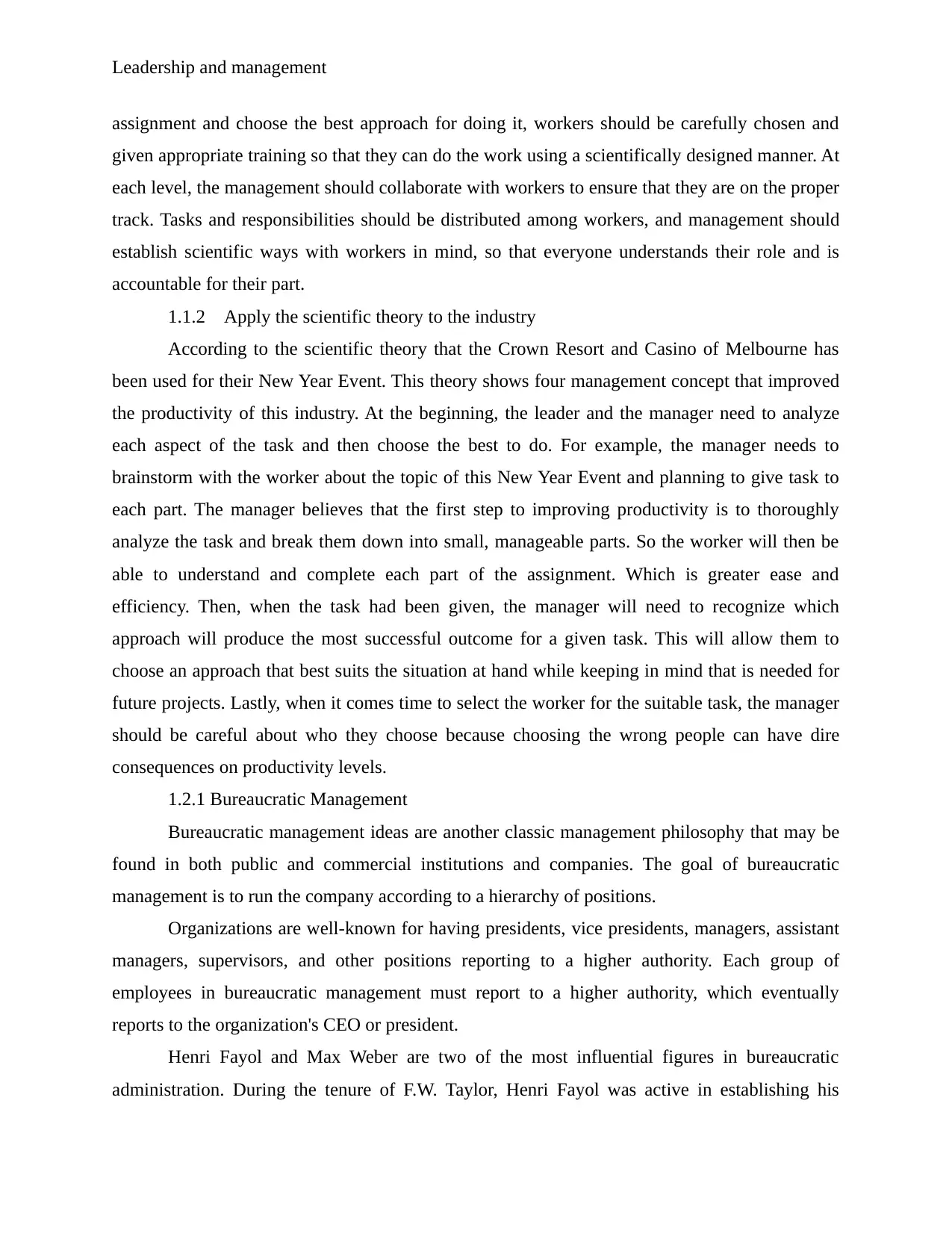
Leadership and management
assignment and choose the best approach for doing it, workers should be carefully chosen and
given appropriate training so that they can do the work using a scientifically designed manner. At
each level, the management should collaborate with workers to ensure that they are on the proper
track. Tasks and responsibilities should be distributed among workers, and management should
establish scientific ways with workers in mind, so that everyone understands their role and is
accountable for their part.
1.1.2 Apply the scientific theory to the industry
According to the scientific theory that the Crown Resort and Casino of Melbourne has
been used for their New Year Event. This theory shows four management concept that improved
the productivity of this industry. At the beginning, the leader and the manager need to analyze
each aspect of the task and then choose the best to do. For example, the manager needs to
brainstorm with the worker about the topic of this New Year Event and planning to give task to
each part. The manager believes that the first step to improving productivity is to thoroughly
analyze the task and break them down into small, manageable parts. So the worker will then be
able to understand and complete each part of the assignment. Which is greater ease and
efficiency. Then, when the task had been given, the manager will need to recognize which
approach will produce the most successful outcome for a given task. This will allow them to
choose an approach that best suits the situation at hand while keeping in mind that is needed for
future projects. Lastly, when it comes time to select the worker for the suitable task, the manager
should be careful about who they choose because choosing the wrong people can have dire
consequences on productivity levels.
1.2.1 Bureaucratic Management
Bureaucratic management ideas are another classic management philosophy that may be
found in both public and commercial institutions and companies. The goal of bureaucratic
management is to run the company according to a hierarchy of positions.
Organizations are well-known for having presidents, vice presidents, managers, assistant
managers, supervisors, and other positions reporting to a higher authority. Each group of
employees in bureaucratic management must report to a higher authority, which eventually
reports to the organization's CEO or president.
Henri Fayol and Max Weber are two of the most influential figures in bureaucratic
administration. During the tenure of F.W. Taylor, Henri Fayol was active in establishing his
assignment and choose the best approach for doing it, workers should be carefully chosen and
given appropriate training so that they can do the work using a scientifically designed manner. At
each level, the management should collaborate with workers to ensure that they are on the proper
track. Tasks and responsibilities should be distributed among workers, and management should
establish scientific ways with workers in mind, so that everyone understands their role and is
accountable for their part.
1.1.2 Apply the scientific theory to the industry
According to the scientific theory that the Crown Resort and Casino of Melbourne has
been used for their New Year Event. This theory shows four management concept that improved
the productivity of this industry. At the beginning, the leader and the manager need to analyze
each aspect of the task and then choose the best to do. For example, the manager needs to
brainstorm with the worker about the topic of this New Year Event and planning to give task to
each part. The manager believes that the first step to improving productivity is to thoroughly
analyze the task and break them down into small, manageable parts. So the worker will then be
able to understand and complete each part of the assignment. Which is greater ease and
efficiency. Then, when the task had been given, the manager will need to recognize which
approach will produce the most successful outcome for a given task. This will allow them to
choose an approach that best suits the situation at hand while keeping in mind that is needed for
future projects. Lastly, when it comes time to select the worker for the suitable task, the manager
should be careful about who they choose because choosing the wrong people can have dire
consequences on productivity levels.
1.2.1 Bureaucratic Management
Bureaucratic management ideas are another classic management philosophy that may be
found in both public and commercial institutions and companies. The goal of bureaucratic
management is to run the company according to a hierarchy of positions.
Organizations are well-known for having presidents, vice presidents, managers, assistant
managers, supervisors, and other positions reporting to a higher authority. Each group of
employees in bureaucratic management must report to a higher authority, which eventually
reports to the organization's CEO or president.
Henri Fayol and Max Weber are two of the most influential figures in bureaucratic
administration. During the tenure of F.W. Taylor, Henri Fayol was active in establishing his
⊘ This is a preview!⊘
Do you want full access?
Subscribe today to unlock all pages.

Trusted by 1+ million students worldwide
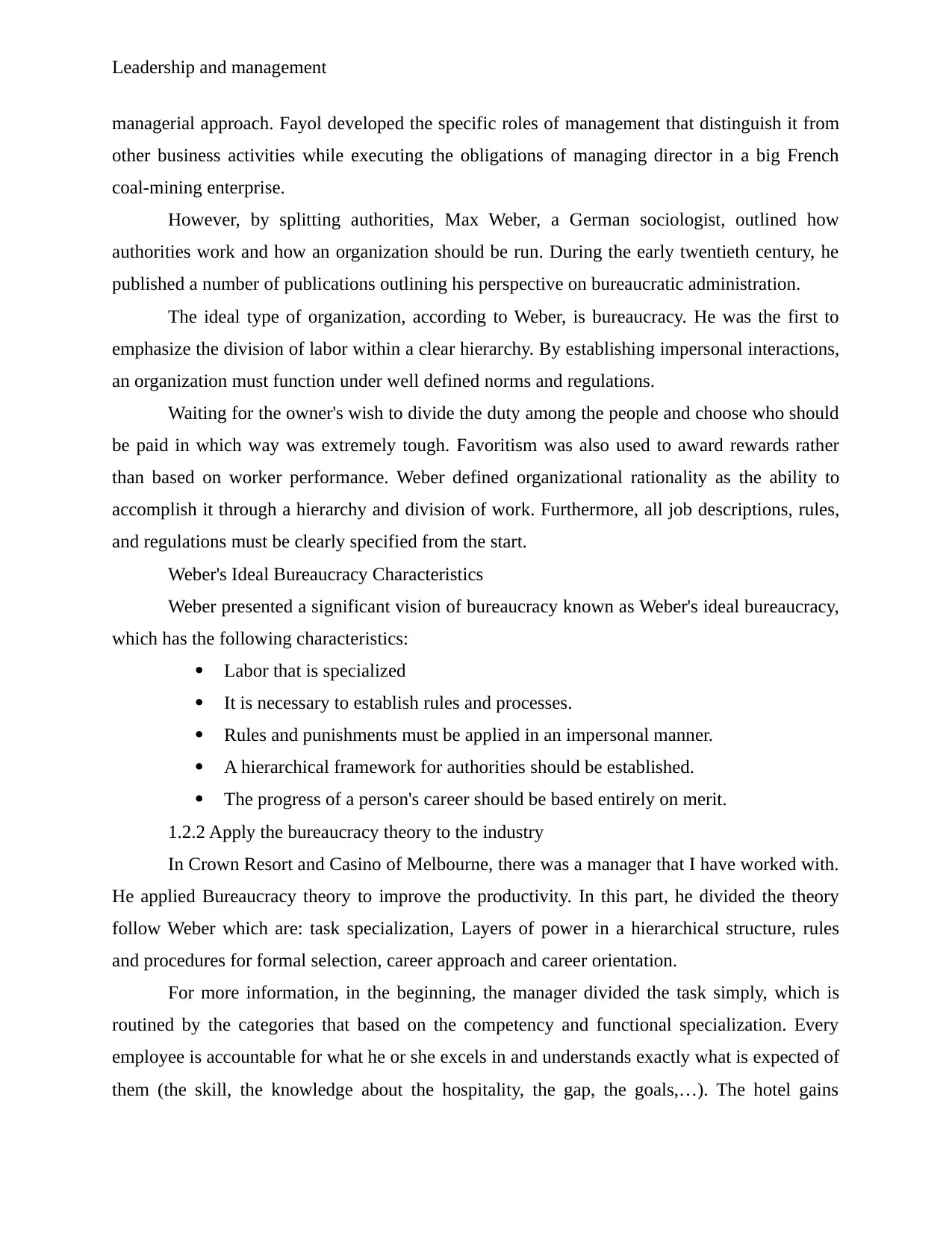
Leadership and management
managerial approach. Fayol developed the specific roles of management that distinguish it from
other business activities while executing the obligations of managing director in a big French
coal-mining enterprise.
However, by splitting authorities, Max Weber, a German sociologist, outlined how
authorities work and how an organization should be run. During the early twentieth century, he
published a number of publications outlining his perspective on bureaucratic administration.
The ideal type of organization, according to Weber, is bureaucracy. He was the first to
emphasize the division of labor within a clear hierarchy. By establishing impersonal interactions,
an organization must function under well defined norms and regulations.
Waiting for the owner's wish to divide the duty among the people and choose who should
be paid in which way was extremely tough. Favoritism was also used to award rewards rather
than based on worker performance. Weber defined organizational rationality as the ability to
accomplish it through a hierarchy and division of work. Furthermore, all job descriptions, rules,
and regulations must be clearly specified from the start.
Weber's Ideal Bureaucracy Characteristics
Weber presented a significant vision of bureaucracy known as Weber's ideal bureaucracy,
which has the following characteristics:
Labor that is specialized
It is necessary to establish rules and processes.
Rules and punishments must be applied in an impersonal manner.
A hierarchical framework for authorities should be established.
The progress of a person's career should be based entirely on merit.
1.2.2 Apply the bureaucracy theory to the industry
In Crown Resort and Casino of Melbourne, there was a manager that I have worked with.
He applied Bureaucracy theory to improve the productivity. In this part, he divided the theory
follow Weber which are: task specialization, Layers of power in a hierarchical structure, rules
and procedures for formal selection, career approach and career orientation.
For more information, in the beginning, the manager divided the task simply, which is
routined by the categories that based on the competency and functional specialization. Every
employee is accountable for what he or she excels in and understands exactly what is expected of
them (the skill, the knowledge about the hospitality, the gap, the goals,…). The hotel gains
managerial approach. Fayol developed the specific roles of management that distinguish it from
other business activities while executing the obligations of managing director in a big French
coal-mining enterprise.
However, by splitting authorities, Max Weber, a German sociologist, outlined how
authorities work and how an organization should be run. During the early twentieth century, he
published a number of publications outlining his perspective on bureaucratic administration.
The ideal type of organization, according to Weber, is bureaucracy. He was the first to
emphasize the division of labor within a clear hierarchy. By establishing impersonal interactions,
an organization must function under well defined norms and regulations.
Waiting for the owner's wish to divide the duty among the people and choose who should
be paid in which way was extremely tough. Favoritism was also used to award rewards rather
than based on worker performance. Weber defined organizational rationality as the ability to
accomplish it through a hierarchy and division of work. Furthermore, all job descriptions, rules,
and regulations must be clearly specified from the start.
Weber's Ideal Bureaucracy Characteristics
Weber presented a significant vision of bureaucracy known as Weber's ideal bureaucracy,
which has the following characteristics:
Labor that is specialized
It is necessary to establish rules and processes.
Rules and punishments must be applied in an impersonal manner.
A hierarchical framework for authorities should be established.
The progress of a person's career should be based entirely on merit.
1.2.2 Apply the bureaucracy theory to the industry
In Crown Resort and Casino of Melbourne, there was a manager that I have worked with.
He applied Bureaucracy theory to improve the productivity. In this part, he divided the theory
follow Weber which are: task specialization, Layers of power in a hierarchical structure, rules
and procedures for formal selection, career approach and career orientation.
For more information, in the beginning, the manager divided the task simply, which is
routined by the categories that based on the competency and functional specialization. Every
employee is accountable for what he or she excels in and understands exactly what is expected of
them (the skill, the knowledge about the hospitality, the gap, the goals,…). The hotel gains
Paraphrase This Document
Need a fresh take? Get an instant paraphrase of this document with our AI Paraphraser
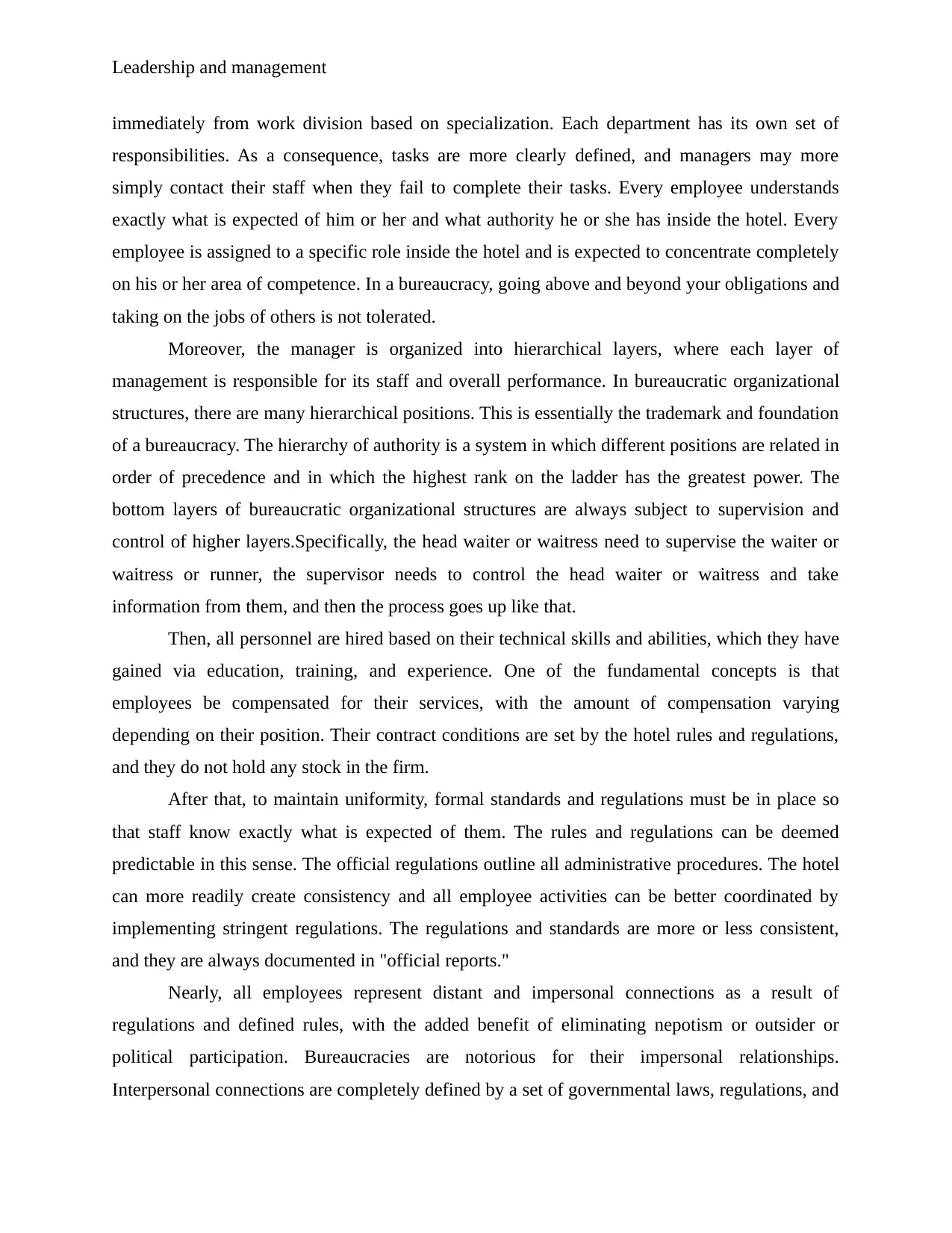
Leadership and management
immediately from work division based on specialization. Each department has its own set of
responsibilities. As a consequence, tasks are more clearly defined, and managers may more
simply contact their staff when they fail to complete their tasks. Every employee understands
exactly what is expected of him or her and what authority he or she has inside the hotel. Every
employee is assigned to a specific role inside the hotel and is expected to concentrate completely
on his or her area of competence. In a bureaucracy, going above and beyond your obligations and
taking on the jobs of others is not tolerated.
Moreover, the manager is organized into hierarchical layers, where each layer of
management is responsible for its staff and overall performance. In bureaucratic organizational
structures, there are many hierarchical positions. This is essentially the trademark and foundation
of a bureaucracy. The hierarchy of authority is a system in which different positions are related in
order of precedence and in which the highest rank on the ladder has the greatest power. The
bottom layers of bureaucratic organizational structures are always subject to supervision and
control of higher layers.Specifically, the head waiter or waitress need to supervise the waiter or
waitress or runner, the supervisor needs to control the head waiter or waitress and take
information from them, and then the process goes up like that.
Then, all personnel are hired based on their technical skills and abilities, which they have
gained via education, training, and experience. One of the fundamental concepts is that
employees be compensated for their services, with the amount of compensation varying
depending on their position. Their contract conditions are set by the hotel rules and regulations,
and they do not hold any stock in the firm.
After that, to maintain uniformity, formal standards and regulations must be in place so
that staff know exactly what is expected of them. The rules and regulations can be deemed
predictable in this sense. The official regulations outline all administrative procedures. The hotel
can more readily create consistency and all employee activities can be better coordinated by
implementing stringent regulations. The regulations and standards are more or less consistent,
and they are always documented in "official reports."
Nearly, all employees represent distant and impersonal connections as a result of
regulations and defined rules, with the added benefit of eliminating nepotism or outsider or
political participation. Bureaucracies are notorious for their impersonal relationships.
Interpersonal connections are completely defined by a set of governmental laws, regulations, and
immediately from work division based on specialization. Each department has its own set of
responsibilities. As a consequence, tasks are more clearly defined, and managers may more
simply contact their staff when they fail to complete their tasks. Every employee understands
exactly what is expected of him or her and what authority he or she has inside the hotel. Every
employee is assigned to a specific role inside the hotel and is expected to concentrate completely
on his or her area of competence. In a bureaucracy, going above and beyond your obligations and
taking on the jobs of others is not tolerated.
Moreover, the manager is organized into hierarchical layers, where each layer of
management is responsible for its staff and overall performance. In bureaucratic organizational
structures, there are many hierarchical positions. This is essentially the trademark and foundation
of a bureaucracy. The hierarchy of authority is a system in which different positions are related in
order of precedence and in which the highest rank on the ladder has the greatest power. The
bottom layers of bureaucratic organizational structures are always subject to supervision and
control of higher layers.Specifically, the head waiter or waitress need to supervise the waiter or
waitress or runner, the supervisor needs to control the head waiter or waitress and take
information from them, and then the process goes up like that.
Then, all personnel are hired based on their technical skills and abilities, which they have
gained via education, training, and experience. One of the fundamental concepts is that
employees be compensated for their services, with the amount of compensation varying
depending on their position. Their contract conditions are set by the hotel rules and regulations,
and they do not hold any stock in the firm.
After that, to maintain uniformity, formal standards and regulations must be in place so
that staff know exactly what is expected of them. The rules and regulations can be deemed
predictable in this sense. The official regulations outline all administrative procedures. The hotel
can more readily create consistency and all employee activities can be better coordinated by
implementing stringent regulations. The regulations and standards are more or less consistent,
and they are always documented in "official reports."
Nearly, all employees represent distant and impersonal connections as a result of
regulations and defined rules, with the added benefit of eliminating nepotism or outsider or
political participation. Bureaucracies are notorious for their impersonal relationships.
Interpersonal connections are completely defined by a set of governmental laws, regulations, and
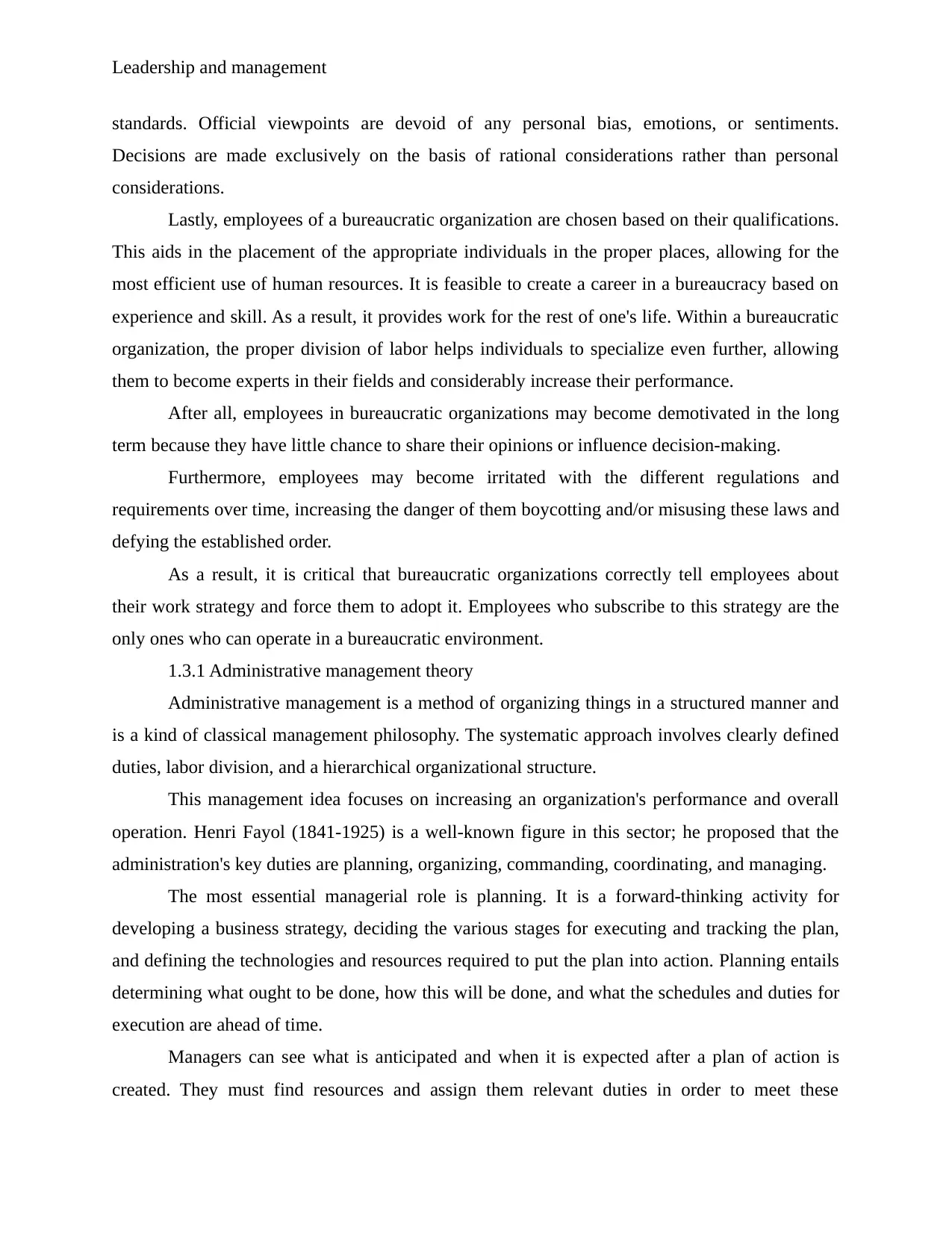
Leadership and management
standards. Official viewpoints are devoid of any personal bias, emotions, or sentiments.
Decisions are made exclusively on the basis of rational considerations rather than personal
considerations.
Lastly, employees of a bureaucratic organization are chosen based on their qualifications.
This aids in the placement of the appropriate individuals in the proper places, allowing for the
most efficient use of human resources. It is feasible to create a career in a bureaucracy based on
experience and skill. As a result, it provides work for the rest of one's life. Within a bureaucratic
organization, the proper division of labor helps individuals to specialize even further, allowing
them to become experts in their fields and considerably increase their performance.
After all, employees in bureaucratic organizations may become demotivated in the long
term because they have little chance to share their opinions or influence decision-making.
Furthermore, employees may become irritated with the different regulations and
requirements over time, increasing the danger of them boycotting and/or misusing these laws and
defying the established order.
As a result, it is critical that bureaucratic organizations correctly tell employees about
their work strategy and force them to adopt it. Employees who subscribe to this strategy are the
only ones who can operate in a bureaucratic environment.
1.3.1 Administrative management theory
Administrative management is a method of organizing things in a structured manner and
is a kind of classical management philosophy. The systematic approach involves clearly defined
duties, labor division, and a hierarchical organizational structure.
This management idea focuses on increasing an organization's performance and overall
operation. Henri Fayol (1841-1925) is a well-known figure in this sector; he proposed that the
administration's key duties are planning, organizing, commanding, coordinating, and managing.
The most essential managerial role is planning. It is a forward-thinking activity for
developing a business strategy, deciding the various stages for executing and tracking the plan,
and defining the technologies and resources required to put the plan into action. Planning entails
determining what ought to be done, how this will be done, and what the schedules and duties for
execution are ahead of time.
Managers can see what is anticipated and when it is expected after a plan of action is
created. They must find resources and assign them relevant duties in order to meet these
standards. Official viewpoints are devoid of any personal bias, emotions, or sentiments.
Decisions are made exclusively on the basis of rational considerations rather than personal
considerations.
Lastly, employees of a bureaucratic organization are chosen based on their qualifications.
This aids in the placement of the appropriate individuals in the proper places, allowing for the
most efficient use of human resources. It is feasible to create a career in a bureaucracy based on
experience and skill. As a result, it provides work for the rest of one's life. Within a bureaucratic
organization, the proper division of labor helps individuals to specialize even further, allowing
them to become experts in their fields and considerably increase their performance.
After all, employees in bureaucratic organizations may become demotivated in the long
term because they have little chance to share their opinions or influence decision-making.
Furthermore, employees may become irritated with the different regulations and
requirements over time, increasing the danger of them boycotting and/or misusing these laws and
defying the established order.
As a result, it is critical that bureaucratic organizations correctly tell employees about
their work strategy and force them to adopt it. Employees who subscribe to this strategy are the
only ones who can operate in a bureaucratic environment.
1.3.1 Administrative management theory
Administrative management is a method of organizing things in a structured manner and
is a kind of classical management philosophy. The systematic approach involves clearly defined
duties, labor division, and a hierarchical organizational structure.
This management idea focuses on increasing an organization's performance and overall
operation. Henri Fayol (1841-1925) is a well-known figure in this sector; he proposed that the
administration's key duties are planning, organizing, commanding, coordinating, and managing.
The most essential managerial role is planning. It is a forward-thinking activity for
developing a business strategy, deciding the various stages for executing and tracking the plan,
and defining the technologies and resources required to put the plan into action. Planning entails
determining what ought to be done, how this will be done, and what the schedules and duties for
execution are ahead of time.
Managers can see what is anticipated and when it is expected after a plan of action is
created. They must find resources and assign them relevant duties in order to meet these
⊘ This is a preview!⊘
Do you want full access?
Subscribe today to unlock all pages.

Trusted by 1+ million students worldwide
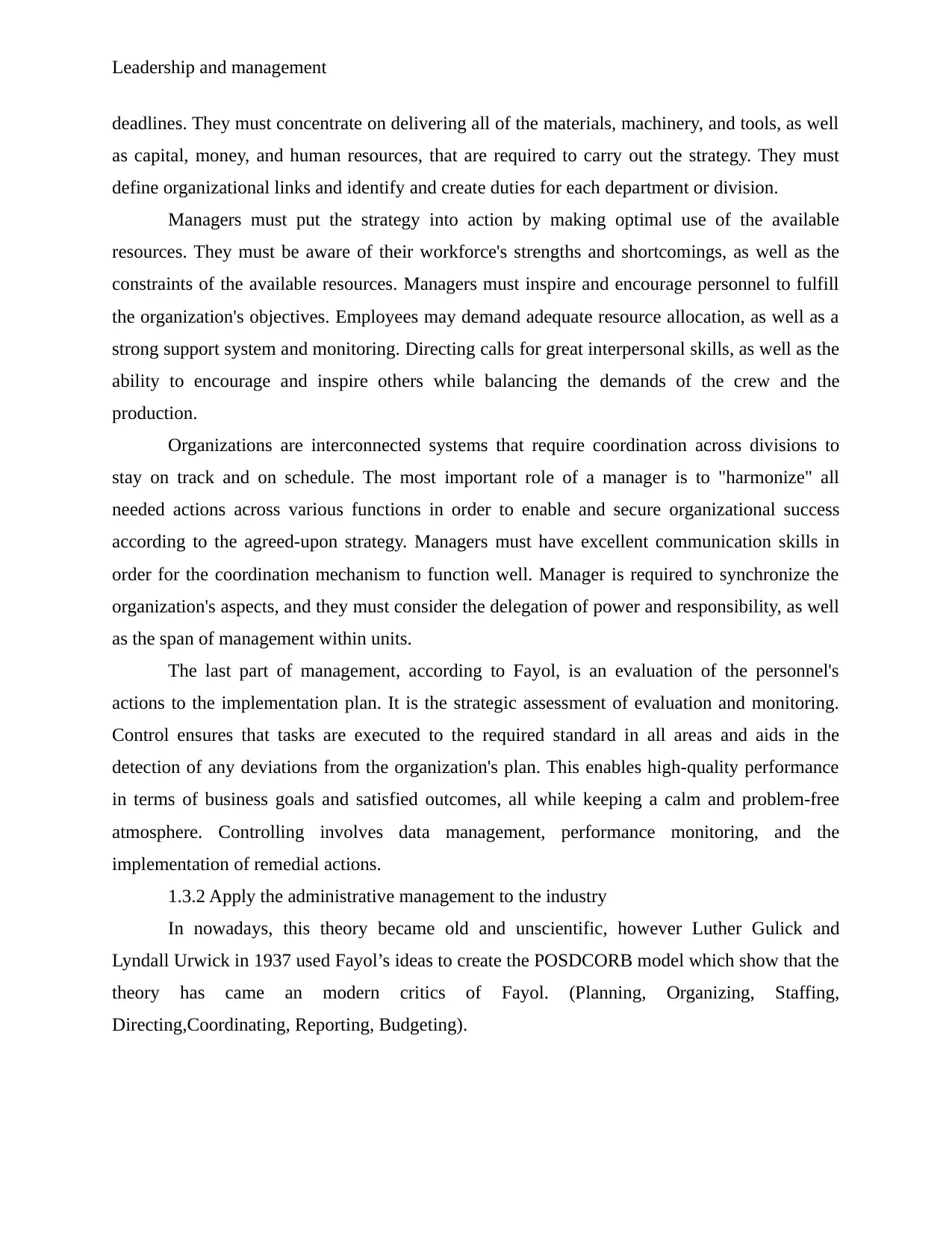
Leadership and management
deadlines. They must concentrate on delivering all of the materials, machinery, and tools, as well
as capital, money, and human resources, that are required to carry out the strategy. They must
define organizational links and identify and create duties for each department or division.
Managers must put the strategy into action by making optimal use of the available
resources. They must be aware of their workforce's strengths and shortcomings, as well as the
constraints of the available resources. Managers must inspire and encourage personnel to fulfill
the organization's objectives. Employees may demand adequate resource allocation, as well as a
strong support system and monitoring. Directing calls for great interpersonal skills, as well as the
ability to encourage and inspire others while balancing the demands of the crew and the
production.
Organizations are interconnected systems that require coordination across divisions to
stay on track and on schedule. The most important role of a manager is to "harmonize" all
needed actions across various functions in order to enable and secure organizational success
according to the agreed-upon strategy. Managers must have excellent communication skills in
order for the coordination mechanism to function well. Manager is required to synchronize the
organization's aspects, and they must consider the delegation of power and responsibility, as well
as the span of management within units.
The last part of management, according to Fayol, is an evaluation of the personnel's
actions to the implementation plan. It is the strategic assessment of evaluation and monitoring.
Control ensures that tasks are executed to the required standard in all areas and aids in the
detection of any deviations from the organization's plan. This enables high-quality performance
in terms of business goals and satisfied outcomes, all while keeping a calm and problem-free
atmosphere. Controlling involves data management, performance monitoring, and the
implementation of remedial actions.
1.3.2 Apply the administrative management to the industry
In nowadays, this theory became old and unscientific, however Luther Gulick and
Lyndall Urwick in 1937 used Fayol’s ideas to create the POSDCORB model which show that the
theory has came an modern critics of Fayol. (Planning, Organizing, Staffing,
Directing,Coordinating, Reporting, Budgeting).
deadlines. They must concentrate on delivering all of the materials, machinery, and tools, as well
as capital, money, and human resources, that are required to carry out the strategy. They must
define organizational links and identify and create duties for each department or division.
Managers must put the strategy into action by making optimal use of the available
resources. They must be aware of their workforce's strengths and shortcomings, as well as the
constraints of the available resources. Managers must inspire and encourage personnel to fulfill
the organization's objectives. Employees may demand adequate resource allocation, as well as a
strong support system and monitoring. Directing calls for great interpersonal skills, as well as the
ability to encourage and inspire others while balancing the demands of the crew and the
production.
Organizations are interconnected systems that require coordination across divisions to
stay on track and on schedule. The most important role of a manager is to "harmonize" all
needed actions across various functions in order to enable and secure organizational success
according to the agreed-upon strategy. Managers must have excellent communication skills in
order for the coordination mechanism to function well. Manager is required to synchronize the
organization's aspects, and they must consider the delegation of power and responsibility, as well
as the span of management within units.
The last part of management, according to Fayol, is an evaluation of the personnel's
actions to the implementation plan. It is the strategic assessment of evaluation and monitoring.
Control ensures that tasks are executed to the required standard in all areas and aids in the
detection of any deviations from the organization's plan. This enables high-quality performance
in terms of business goals and satisfied outcomes, all while keeping a calm and problem-free
atmosphere. Controlling involves data management, performance monitoring, and the
implementation of remedial actions.
1.3.2 Apply the administrative management to the industry
In nowadays, this theory became old and unscientific, however Luther Gulick and
Lyndall Urwick in 1937 used Fayol’s ideas to create the POSDCORB model which show that the
theory has came an modern critics of Fayol. (Planning, Organizing, Staffing,
Directing,Coordinating, Reporting, Budgeting).
Paraphrase This Document
Need a fresh take? Get an instant paraphrase of this document with our AI Paraphraser
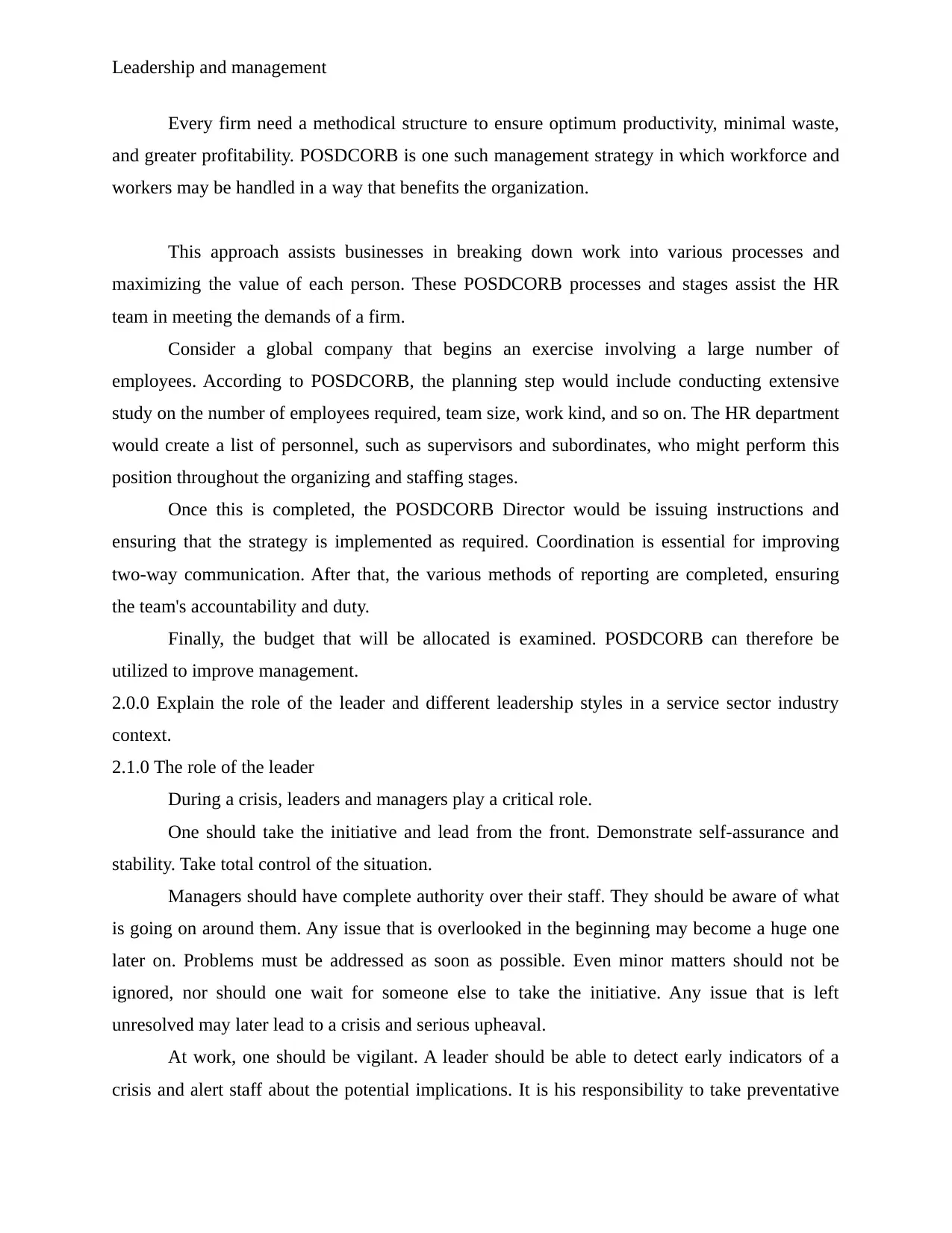
Leadership and management
Every firm need a methodical structure to ensure optimum productivity, minimal waste,
and greater profitability. POSDCORB is one such management strategy in which workforce and
workers may be handled in a way that benefits the organization.
This approach assists businesses in breaking down work into various processes and
maximizing the value of each person. These POSDCORB processes and stages assist the HR
team in meeting the demands of a firm.
Consider a global company that begins an exercise involving a large number of
employees. According to POSDCORB, the planning step would include conducting extensive
study on the number of employees required, team size, work kind, and so on. The HR department
would create a list of personnel, such as supervisors and subordinates, who might perform this
position throughout the organizing and staffing stages.
Once this is completed, the POSDCORB Director would be issuing instructions and
ensuring that the strategy is implemented as required. Coordination is essential for improving
two-way communication. After that, the various methods of reporting are completed, ensuring
the team's accountability and duty.
Finally, the budget that will be allocated is examined. POSDCORB can therefore be
utilized to improve management.
2.0.0 Explain the role of the leader and different leadership styles in a service sector industry
context.
2.1.0 The role of the leader
During a crisis, leaders and managers play a critical role.
One should take the initiative and lead from the front. Demonstrate self-assurance and
stability. Take total control of the situation.
Managers should have complete authority over their staff. They should be aware of what
is going on around them. Any issue that is overlooked in the beginning may become a huge one
later on. Problems must be addressed as soon as possible. Even minor matters should not be
ignored, nor should one wait for someone else to take the initiative. Any issue that is left
unresolved may later lead to a crisis and serious upheaval.
At work, one should be vigilant. A leader should be able to detect early indicators of a
crisis and alert staff about the potential implications. It is his responsibility to take preventative
Every firm need a methodical structure to ensure optimum productivity, minimal waste,
and greater profitability. POSDCORB is one such management strategy in which workforce and
workers may be handled in a way that benefits the organization.
This approach assists businesses in breaking down work into various processes and
maximizing the value of each person. These POSDCORB processes and stages assist the HR
team in meeting the demands of a firm.
Consider a global company that begins an exercise involving a large number of
employees. According to POSDCORB, the planning step would include conducting extensive
study on the number of employees required, team size, work kind, and so on. The HR department
would create a list of personnel, such as supervisors and subordinates, who might perform this
position throughout the organizing and staffing stages.
Once this is completed, the POSDCORB Director would be issuing instructions and
ensuring that the strategy is implemented as required. Coordination is essential for improving
two-way communication. After that, the various methods of reporting are completed, ensuring
the team's accountability and duty.
Finally, the budget that will be allocated is examined. POSDCORB can therefore be
utilized to improve management.
2.0.0 Explain the role of the leader and different leadership styles in a service sector industry
context.
2.1.0 The role of the leader
During a crisis, leaders and managers play a critical role.
One should take the initiative and lead from the front. Demonstrate self-assurance and
stability. Take total control of the situation.
Managers should have complete authority over their staff. They should be aware of what
is going on around them. Any issue that is overlooked in the beginning may become a huge one
later on. Problems must be addressed as soon as possible. Even minor matters should not be
ignored, nor should one wait for someone else to take the initiative. Any issue that is left
unresolved may later lead to a crisis and serious upheaval.
At work, one should be vigilant. A leader should be able to detect early indicators of a
crisis and alert staff about the potential implications. It is his responsibility to take preventative
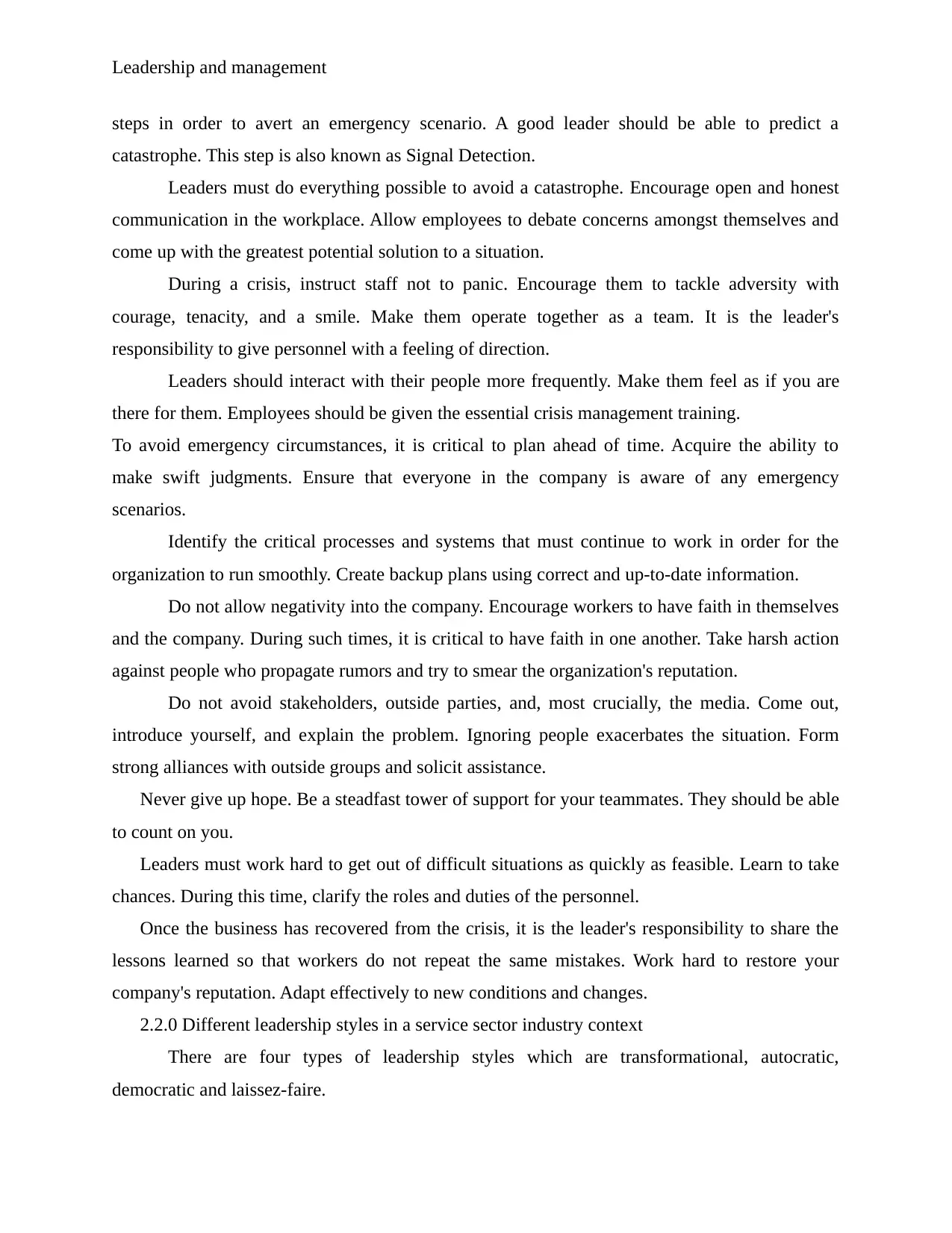
Leadership and management
steps in order to avert an emergency scenario. A good leader should be able to predict a
catastrophe. This step is also known as Signal Detection.
Leaders must do everything possible to avoid a catastrophe. Encourage open and honest
communication in the workplace. Allow employees to debate concerns amongst themselves and
come up with the greatest potential solution to a situation.
During a crisis, instruct staff not to panic. Encourage them to tackle adversity with
courage, tenacity, and a smile. Make them operate together as a team. It is the leader's
responsibility to give personnel with a feeling of direction.
Leaders should interact with their people more frequently. Make them feel as if you are
there for them. Employees should be given the essential crisis management training.
To avoid emergency circumstances, it is critical to plan ahead of time. Acquire the ability to
make swift judgments. Ensure that everyone in the company is aware of any emergency
scenarios.
Identify the critical processes and systems that must continue to work in order for the
organization to run smoothly. Create backup plans using correct and up-to-date information.
Do not allow negativity into the company. Encourage workers to have faith in themselves
and the company. During such times, it is critical to have faith in one another. Take harsh action
against people who propagate rumors and try to smear the organization's reputation.
Do not avoid stakeholders, outside parties, and, most crucially, the media. Come out,
introduce yourself, and explain the problem. Ignoring people exacerbates the situation. Form
strong alliances with outside groups and solicit assistance.
Never give up hope. Be a steadfast tower of support for your teammates. They should be able
to count on you.
Leaders must work hard to get out of difficult situations as quickly as feasible. Learn to take
chances. During this time, clarify the roles and duties of the personnel.
Once the business has recovered from the crisis, it is the leader's responsibility to share the
lessons learned so that workers do not repeat the same mistakes. Work hard to restore your
company's reputation. Adapt effectively to new conditions and changes.
2.2.0 Different leadership styles in a service sector industry context
There are four types of leadership styles which are transformational, autocratic,
democratic and laissez-faire.
steps in order to avert an emergency scenario. A good leader should be able to predict a
catastrophe. This step is also known as Signal Detection.
Leaders must do everything possible to avoid a catastrophe. Encourage open and honest
communication in the workplace. Allow employees to debate concerns amongst themselves and
come up with the greatest potential solution to a situation.
During a crisis, instruct staff not to panic. Encourage them to tackle adversity with
courage, tenacity, and a smile. Make them operate together as a team. It is the leader's
responsibility to give personnel with a feeling of direction.
Leaders should interact with their people more frequently. Make them feel as if you are
there for them. Employees should be given the essential crisis management training.
To avoid emergency circumstances, it is critical to plan ahead of time. Acquire the ability to
make swift judgments. Ensure that everyone in the company is aware of any emergency
scenarios.
Identify the critical processes and systems that must continue to work in order for the
organization to run smoothly. Create backup plans using correct and up-to-date information.
Do not allow negativity into the company. Encourage workers to have faith in themselves
and the company. During such times, it is critical to have faith in one another. Take harsh action
against people who propagate rumors and try to smear the organization's reputation.
Do not avoid stakeholders, outside parties, and, most crucially, the media. Come out,
introduce yourself, and explain the problem. Ignoring people exacerbates the situation. Form
strong alliances with outside groups and solicit assistance.
Never give up hope. Be a steadfast tower of support for your teammates. They should be able
to count on you.
Leaders must work hard to get out of difficult situations as quickly as feasible. Learn to take
chances. During this time, clarify the roles and duties of the personnel.
Once the business has recovered from the crisis, it is the leader's responsibility to share the
lessons learned so that workers do not repeat the same mistakes. Work hard to restore your
company's reputation. Adapt effectively to new conditions and changes.
2.2.0 Different leadership styles in a service sector industry context
There are four types of leadership styles which are transformational, autocratic,
democratic and laissez-faire.
⊘ This is a preview!⊘
Do you want full access?
Subscribe today to unlock all pages.

Trusted by 1+ million students worldwide
1 out of 24
Your All-in-One AI-Powered Toolkit for Academic Success.
+13062052269
info@desklib.com
Available 24*7 on WhatsApp / Email
![[object Object]](/_next/static/media/star-bottom.7253800d.svg)
Unlock your academic potential
Copyright © 2020–2025 A2Z Services. All Rights Reserved. Developed and managed by ZUCOL.